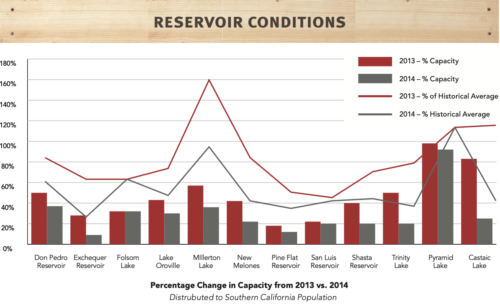Water has undoubtedly been the most discussed topic in California’s agricultural community this past year.
 The concern in a lot of minds is whether California can continue as the world’s leading agricultural center in the face of steady reservoir depletion.
The concern in a lot of minds is whether California can continue as the world’s leading agricultural center in the face of steady reservoir depletion.
While the drought has highlighted seemingly new problems, the California water table has actually been in a steady decline for the past few decades. Only the recent severity has prompted action from environmentalists. Governor Jerry Brown also recently signed a package of bills that will regulate groundwater pumping.
The unprecedented new regulations will take decades to achieve the goal of sustainably replenishing the water basin, with some estimates coming in around the year 2040. Well before then, these new regulations will limit water allowances to farmers and impact both the San Joaquin and Salinas Valleys. Fortunately, tomato crops are one of the most efficient users of water (using only 4% of California’s crop acreage allocation), especially when compared to orchards and forage crops. The use of drip irrigation, rather than flood, has also helped tomato farmers increase their water use efficiency.
In October 2014 the state set a new record for tons harvested at over 14 million short tons compared to the previous 2009 record of 13,313,051. The crop surpassed issues of drought, warmer than normal temperatures, strong winds, along with well failures and curtailed pumping from the San Joaquin Delta. The record tomato crop demonstrates the long-term economic viability of growing tomatoes in California.
Weather played into crop performance in both positive and negative ways this season. The dry 2013/2014 winter helped to create an inhospitable environment to 2013 crop’s prominent virus, Curly Top. Mold was down to an average of 1.2% versus 1.5% in 2013. High temperatures during planting season caused a lengthy season (ending on October 27th), which resulted in processors paying late-season premiums of up to $15 per ton and facing lower incoming solids (5.16 versus 5.22 in 2013). To put the lower solids in perspective, the impact on the 2014 pack is the equivalent of 161,000 tons of tomatoes.
Looking forward, we can expect water to continue to be at the forefront of both growers and processors’ minds. The coming years will provide both groups with unique opportunities to work together and ensure California’s role as the global leader in tomato production.

Morning Star Newsletter now distributed electronically
As a reminder, Morning Star is now distributing our newsletters electronically using an email distribution vendor called Mailchimp. Your e-version will now include informative Morning Star videos and highlights. Depending on your company's firewall, these emails may initially be directed to you spam folder.

